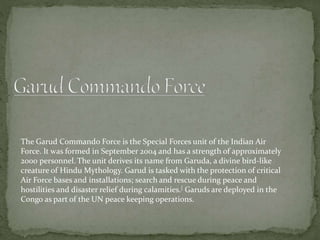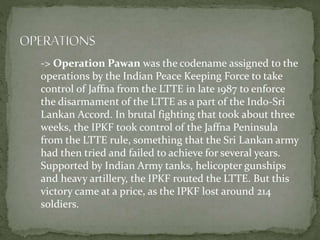ARMY NEW.pptx
- 2. ïMARCOS ï NATIONAL SECURITY GUARDS (NSG) ïPARA COMMANDOS ïSPECIAL PROTECTION GROUP (SPG) 1) MARCOS. ï Garud Commando Force. ï4) Ghatak Force. ï6) COBRA (Commando Battalion for Resolute Action) ï7) Special Frontier Force. ï8) Force One. DIFFERENT SPECIAL FORCES IN INDIA
- 3. The Garud Commando Force is the Special Forces unit of the Indian Air Force. It was formed in September 2004 and has a strength of approximately 2000 personnel. The unit derives its name from Garuda, a divine bird-like creature of Hindu Mythology. Garud is tasked with the protection of critical Air Force bases and installations; search and rescue during peace and hostilities and disaster relief during calamities.[ Garuds are deployed in the Congo as part of the UN peace keeping operations.
- 4. During hostilities, Garuds undertake combat search and rescue, rescue of downed airmen and other forces from behind enemy lines, suppression of enemy air defence (SEAD), radar busting, combat control, missile and munitions guidance ("lasing" of targets) and other missions in support of air operations. It has been suggested that they undertake an offensive role including raids on enemy air bases etc. during times of war. Apart from protecting air bases from sabotage and attacks by commando raids, they are also tasked to seal off weapons systems, fighter hangars and other major systems during intrusions and conflicts.[
- 5. Garud trainees undergo a 72-week. Basic Training course, which is the longest among all the Indian special forces but it also includes basic training. The total duration of training before a trainee can qualify as a fully operational Garud is around 3 years. The initial phase is a three-month probationary training which filters in the promising candidates for the next phases of training. This phase, which usually has a high attrition (Drop-out) rate is conducted at the Garud Regimental Training Centre located at Hindon, Ghaziabad which is near to New Delhi. .[
- 6. Formed in 1966, the Para (SF) are the largest and most important part of the Special Forces of India. They are a part of the highly trained Parachute Regiment of the Indian Army. The main aim of having a Parachute Regiment is for quick deployment of soldiers behind the enemy lines to attack the enemy from behind and destroy their first line of defence. Para (SF) conducted a series of joint exercises with US army special forces called Vajra Prahar.
- 7. The parachute units of the Indian Army are among the oldest airborne units in the world. The 50th Indian Parachute Brigade was formed on 27 October 1941, comprising the British 151st Parachute Battalion, the British Indian Army 152nd Indian Parachute Battalion, and the 153rd Gurkha Parachute Battalion. The Parachute Regiment was formed from these and several other units in 1952. In 1944, the 50th was allocated to the newly founded 44th Airborne Division. In the post-independence restructuring, India retained only one parachute brigadeâthe 50th. This brigade consisted of three distinguished battalions personally nominated by the then Commander-in-Chief, namely 1 PARA (Punjab), 2 PARA (Maratha) and 3 PARA (Kumaon). During the Jammu and Kashmir operations of 1947-48 these battalions distinguished themselves with glory in the battles of Shelatang, Naushera, Jhangar and Poonch and were awarded the respective Battle Honours.
- 8. OPERATIONS âĒ 1971 Indo-Pakistan War The unit (Para Commandos, Indian Army) first saw action in the 1971 Indo-Pakistani war, the first six-man assault team was inserted 240 kilometres (150 miles) deep into Indus and Charchao, where they carried out raids. The assault team killed 73 and wounded 140 on the Pakistani side. In addition, they also destroyed 35mm artillery guns of the Pakistan independent battery. âĒOperation Bluestar 1984 In 1984 the Para (SF) were involved in Operation Blue Star They were charged to lead an attack on the Holy Site of the Sikh religion the Golden Temple to evict Sikh militants in Punjab âĒSri Lanka 198 The late 1980s saw the Para (SF) in action in Sri Lanka, as part of Operation Pawan. However, the lack of proper planning by the Indian Peace Keeping Force (IPKF), and insufficient intelligence on the Liberation Tigers of Tamil Eelam's (LTTE) whereabouts, caused the initial heli-borne assault
- 10. The NSG has a total personnel strength of about 14,500. The NSG was modelled on the pattern of the SAS of the UK and GSG-9 of Germany. In the present year NSG is headed by Mr. Jyoti Krishna Dutt
- 13. OPERATIONS âĒ OPERATION BLUE STAR: (June 3 to June 6, 1984) was an Indian military operation ordered by Indira Gandhi, the then Prime Minister of India, to remove Sikh separatists who were amassing weapons in the Golden Temple in Amritsar..
- 14. âĒ Operation Black Thunder: It is the name given to several operations that took place in India in late 1980s to flush out remaining Sikh extremists from Akal Takht. The major Operation Black Thunder took place on April 30, 1986. NSG commandoes stormed the Golden Temple.
- 15. Operation Black Thunder II) took place began May 12, 1988 in Amritsar and ended with the surrender of the militants on May 18
- 16. MARCOS is an elite special operations unit of the Indian Navy. "MARCOS" is short for "Marine Commandosâ. the initial MARCOS group was planned along with the establishment of the NSG in 1986.
- 17. , The first unit was called the Indian Marine Special Force, and was later renamed as Marine Commando Force (MCF) in 1991. no officer ever reveals that he is with the MARCOS;.
- 18. The MARCO is an expert in every kind of weapon, from knives to sniper rifles. To top it, he is both the paratrooper and a combat diver They are also locally known as the Dadiwali Fauj
- 19. -> Operation Pawan was the codename assigned to the operations by the Indian Peace Keeping Force to take control of Jaffna from the LTTE in late 1987 to enforce the disarmament of the LTTE as a part of the Indo-Sri Lankan Accord. In brutal fighting that took about three weeks, the IPKF took control of the Jaffna Peninsula from the LTTE rule, something that the Sri Lankan army had then tried and failed to achieve for several years. Supported by Indian Army tanks, helicopter gunships and heavy artillery, the IPKF routed the LTTE. But this victory came at a price, as the IPKF lost around 214 soldiers.
- 20. -> Operation Cactus part of Indian Navy contingent defending the democratic government of President Maumoon Abdul Gayoom of the Maldives from a coup. The force carried out a highly successful operation to crush a coup in the Maldives. When some 50 mercenaries escaped with more than 25 hostages, including a minister, in a ship, the MCF was pressed into service and successfully seized the ship. ->Operation Tornado: MARCOS stormed the Oberoi/Trident Hotel and the Nariman Building on morning of 27 November 2008 during the 26 November 2008 Mumbai attacks.
- 21. The training is much tougher The first two months is the weeding out phase. The real killer is the âdeath crawlâ Around 10% eventually don the MARCO patch o their right sleeve. And live the life of a hero â in anonymity.
- 22. Small Arms: AK-47 and variants, Colt M16A2, INSAS 5.56 mm, Type 56 assault rifles, Tavor Assault Rifles, HK MP5 sub- machine gun. The 7.62 mm SLR assault rifle and the SVD_Dragunov sniper rifle is used in long range and sniping roles respectively. Previously, crossbows with cyanide tipped arrows were used for silent killing. Transport: H-3 Sea King and Chetak helicopters, Cosmos CE- 2F/X100 two-man submarines EQUIPMENT























